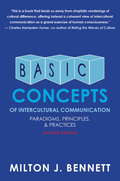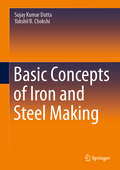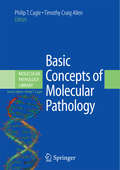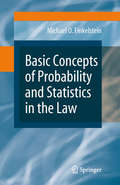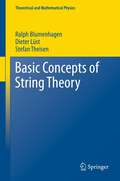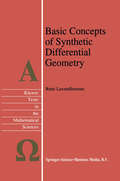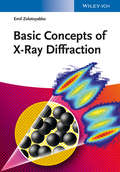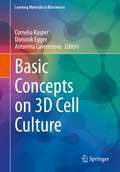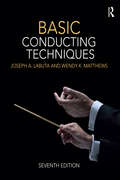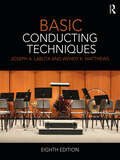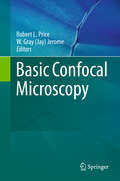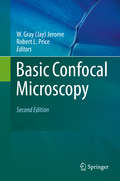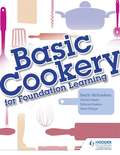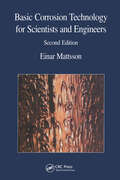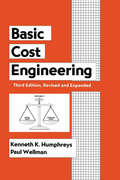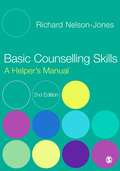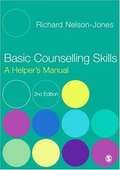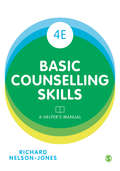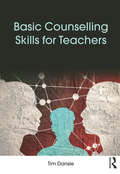- Table View
- List View
Basic Concepts of Intercultural Communication: Paradigms, Principles, and Practices
by Milton BennettIn the long-awaited second edition of Basic Concepts of Intercultural Communication, Milton J. Bennett provides a comprehensive overview of the field from a constructivist perspective. In addition to his insightful analysis, Bennett offers a full complement of classic readings on the topic of intercultural communication, including:• “Science and Linguistics,” by Benjamin Lee Whorf• “The Power of Hidden Differences,” by Edward T. Hall• “Culture: A Perceptual Approach,” by Marshall R. Singer• “Communication in a Global Village,” by Dean Barlund• “Cultural Identity: Reflections on Multiculturalism,” by Peter S. Adler
Basic Concepts of Iron and Steel Making
by Sujay Kumar Dutta Yakshil B. ChokshiThis book presents the fundamentals of iron and steel making, including the physical chemistry, thermodynamics and key concepts, while also discussing associated problems and solutions. It guides the reader through the production process from start to finish, covers the raw materials, and addresses the types of processes and reactions involved in both conventional and alternative methods. Though primarily intended as a textbook for students of metallurgical engineering, the book will also prove a useful reference for professionals and researchers working in this area.
Basic Concepts of Molecular Pathology (Molecular Pathology Library #2)
by Philip T. Cagle Timothy Craig AllenOver the past two decades there has been an explosion in knowledge about the molecular pathology of human diseases which accelerated with the sequencing of the human genome in 2003. Molecular diagnostics and molecular targeted therapy have contributed to the current concept of personalized patient care that is now routine in many medical centers. As a result, general and subspecialty pathologists, clinical practitioners of all types and radiologists must now have an understanding of the basic concepts of molecular pathology and their role in new diagnostic and therapeutic applications to patient care. The Molecular Pathology Library series was created to bridge the gap between traditional basic science textbooks in molecular biology and traditional medical textbooks for organ-specific diseases. Basic Concepts of Molecular Pathology is designed as a stand-alone book to provide the pathologist, clinician or radiologist with a concise review of the essential terminology, concepts and tools of molecular biology that are applied to the understanding, diagnosis and treatment of human diseases in the age of personalized medicine. Those medical practitioners, residents, fellows and students who need to refer to the terminology and concepts of molecular pathology in their patient care will find the Basic Concepts of Molecular Pathology to be a succinct, portable, user-friendly aid in their practice and studies. The service-based physician will find this handy reference to be valuable at the laboratory benchside, at the patient bedside, at multidisciplinary patient care conferences or as a review for examinations.
Basic Concepts of Probability and Statistics in the Law
by Michael O. FinkelsteinWhen as a practicing lawyer I published my ?rst article on statistical evidence in 1966, the editors of the Harvard Law Review told me that a mathematical equa- 1 tion had never before appeared in the review. This hardly seems possible - but if they meant a serious mathematical equation, perhaps they were right. Today all that has changed in legal academia. Whole journals are devoted to scienti?c methods in law or empirical studies of legal institutions. Much of this work involves statistics. Columbia Law School, where I teach, has a professor of law and epidemiology and other law schools have similar “law and” professorships. Many offer courses on statistics (I teach one) or, more broadly, on law and social science. The same is true of practice. Where there are data to parse in a litigation, stat- ticians and other experts using statistical tools now frequently testify. And judges must understand them. In 1993, in its landmark Daubert decision, the Supreme Court commanded federal judges to penetrate scienti?c evidence and ?nd it “re- 2 liable” before allowing it in evidence. It is emblematic of the rise of statistics in the law that the evidence at issue in that much-cited case included a series of epidemiological studies. The Supreme Court’s new requirement made the Federal Judicial Center’s Reference Manual on Scienti?c Evidence, which appeared at about the same time, a best seller. It has several important chapters on statistics.
Basic Concepts of String Theory (Theoretical and Mathematical Physics)
by Ralph Blumenhagen Dieter Lüst Stefan TheisenThe purpose of this book is to thoroughly prepare the reader for research in string theory at an intermediate level. As such it is not a compendium of results but intended as textbook in the sense that most of the material is organized in a pedagogical and self-contained fashion. Beyond the basics, a number of more advanced topics are introduced, such as conformal field theory, superstrings and string dualities - the text does not cover applications to black hole physics and cosmology, nor strings theory at finite temperatures. End-of-chapter references have been added to guide the reader wishing to pursue further studies or to start research in well-defined topics covered by this book.
Basic Concepts of Synthetic Differential Geometry (Texts in the Mathematical Sciences #13)
by R. LavendhommeStarting at an introductory level, the book leads rapidly to important and often new results in synthetic differential geometry. From rudimentary analysis the book moves to such important results as: a new proof of De Rham's theorem; the synthetic view of global action, going as far as the Weil characteristic homomorphism; the systematic account of structured Lie objects, such as Riemannian, symplectic, or Poisson Lie objects; the view of global Lie algebras as Lie algebras of a Lie group in the synthetic sense; and lastly the synthetic construction of symplectic structure on the cotangent bundle in general. Thus while the book is limited to a naive point of view developing synthetic differential geometry as a theory in itself, the author nevertheless treats somewhat advanced topics, which are classic in classical differential geometry but new in the synthetic context. Audience: The book is suitable as an introduction to synthetic differential geometry for students as well as more qualified mathematicians.
Basic Concepts of X-Ray Diffraction
by Emil ZolotoyabkoAuthored by a university professor deeply involved in X-ray diffraction-related research, this textbook is based on his lectures given to graduate students for more than 20 years. It adopts a well-balanced approach, describing basic concepts and experimental techniques, which make X-ray diffraction an unsurpassed method for studying the structure of materials. Both dynamical and kinematic X-ray diffraction is considered from a unified viewpoint, in which the dynamical diffraction in single-scattering approximation serves as a bridge between these two parts. The text emphasizes the fundamental laws that govern the interaction of X-rays with matter, but also covers in detail classical and modern applications, e.g., line broadening, texture and strain/stress analyses, X-ray mapping in reciprocal space, high-resolution X-ray diffraction in the spatial and wave vector domains, X-ray focusing, inelastic and time-resolved X-ray scattering. This unique scope, in combination with otherwise hard-to-find information on analytic expressions for simulating X-ray diffraction profiles in thin-film heterostructures, X-ray interaction with phonons, coherent scattering of Mössbauer radiation, and energy-variable X-ray diffraction, makes the book indispensable for any serious user of X-ray diffraction techniques. Compact and self-contained, this textbook is suitable for students taking X-ray diffraction courses towards specialization in materials science, physics, chemistry, or biology. Numerous clear-cut illustrations, an easy-to-read style of writing, as well as rather short, easily digestible chapters all facilitate comprehension.
Basic Concepts of X-Ray Diffraction
by Emil ZolotoyabkoAuthored by a university professor deeply involved in X-ray diffraction-related research, this textbook is based on his lectures given to graduate students for more than 20 years. It adopts a well-balanced approach, describing basic concepts and experimental techniques, which make X-ray diffraction an unsurpassed method for studying the structure of materials. Both dynamical and kinematic X-ray diffraction is considered from a unified viewpoint, in which the dynamical diffraction in single-scattering approximation serves as a bridge between these two parts. The text emphasizes the fundamental laws that govern the interaction of X-rays with matter, but also covers in detail classical and modern applications, e.g., line broadening, texture and strain/stress analyses, X-ray mapping in reciprocal space, high-resolution X-ray diffraction in the spatial and wave vector domains, X-ray focusing, inelastic and time-resolved X-ray scattering. This unique scope, in combination with otherwise hard-to-find information on analytic expressions for simulating X-ray diffraction profiles in thin-film heterostructures, X-ray interaction with phonons, coherent scattering of Mössbauer radiation, and energy-variable X-ray diffraction, makes the book indispensable for any serious user of X-ray diffraction techniques. Compact and self-contained, this textbook is suitable for students taking X-ray diffraction courses towards specialization in materials science, physics, chemistry, or biology. Numerous clear-cut illustrations, an easy-to-read style of writing, as well as rather short, easily digestible chapters all facilitate comprehension.
Basic Concepts on 3D Cell Culture (Learning Materials in Biosciences)
by Cornelia Kasper Dominik Egger Antonina LavrentievaThis textbook shall introduce the students to 3D cell culture approaches and applications. An overview on existing techniques and equipment is provided and insight into various aspects and challenges that researchers need to consider and face during culture of 3D cells is given. The reader will learn the importance of physiological cell, tissue and organ models and gains important knowledge on 3D analytics. This textbook deepens selected aspects of the textbook “Cell Culture Technology”, which also is published in this series, while offering extended insight into 3D cell culture. The concept of the textbook encompasses various lectures ranging from basics in cell cultivation, tissue engineering, biomaterials and biocompatibility, in vitro test systems and regenerative medicine. The textbook addresses Master- and PhD students interested and/or working in the field of modern cell culture applications and will support the understanding of the essential strategies in 3D cell culture and waken awareness for the potentials and challenges of this application.
Basic Conducting Techniques
by Joseph A. Labuta Wendy K. MatthewsBasic Conducting Techniques, Seventh Edition, provides a clear and intelligible introduction to the art of conducting an ensemble. Over the course of fourteen chapters, the authors explicate the elements of conducting, supplementing their teachings with an extensive selection of musical examples from the classical repertoire. Practical and innovative, clear and approachable, this text illuminates the essential skills a beginning conductor should develop to lead and rehearse a performing group. This new edition features: chapters rewritten to highlight important information and show connections between different sections a new chapter on expressive conducting, consisting of expanded and updated content select full scores in the "Musical Excerpts" section excerpts with transpositions for each chapter, allowing easy access for class performance a new companion website, which includes the scores and transpositions for all musical excerpts, audio recordings of the excerpts, and demonstration videos modeling specific techniques for each chapter. With the beginning conductor in mind, this hands-on, competency-centered approach is appropriate for mixed classes of choral and instrumental music majors, providing indispensable versatility for students and practicing conductors alike. Rooted in decades of teaching and conducting experience, Basic Conducting Techniques is the essential guide to the principles of conducting.
Basic Conducting Techniques
by Joseph A. Labuta Wendy K. MatthewsBasic Conducting Techniques, Seventh Edition, provides a clear and intelligible introduction to the art of conducting an ensemble. Over the course of fourteen chapters, the authors explicate the elements of conducting, supplementing their teachings with an extensive selection of musical examples from the classical repertoire. Practical and innovative, clear and approachable, this text illuminates the essential skills a beginning conductor should develop to lead and rehearse a performing group. This new edition features: chapters rewritten to highlight important information and show connections between different sections a new chapter on expressive conducting, consisting of expanded and updated content select full scores in the "Musical Excerpts" section excerpts with transpositions for each chapter, allowing easy access for class performance a new companion website, which includes the scores and transpositions for all musical excerpts, audio recordings of the excerpts, and demonstration videos modeling specific techniques for each chapter. With the beginning conductor in mind, this hands-on, competency-centered approach is appropriate for mixed classes of choral and instrumental music majors, providing indispensable versatility for students and practicing conductors alike. Rooted in decades of teaching and conducting experience, Basic Conducting Techniques is the essential guide to the principles of conducting.
Basic Conducting Techniques
by Joseph A. Labuta Wendy K. MatthewsNow in its eighth edition, Basic Conducting Techniques provides a clear and intelligible introduction to the art of conducting an ensemble. It has been updated with a greater diversity of repertoire, including contemporary examples and more music by underrepresented composers. Over the course of 14 chapters, the authors explicate the elements of conducting, supplementing their teachings with an extensive selection of musical examples from the classical repertoire. Practical and innovative, clear and approachable, the book illuminates the essential skills that a beginning conductor should develop in order to lead and rehearse a performing group. The companion website provides scores and transposed parts for all musical excerpts, as well as guitar and piano parts, audio recordings of the excerpts, and updated demonstration videos modeling specific conducting techniques. With the beginning conductor in mind, this hands-on, competency-centered approach is appropriate for mixed classes of choral and instrumental music majors, providing indispensable versatility for students and practicing conductors alike. Utilizing decades of teaching and conducting experience, the eighth edition of Basic Conducting Techniques is the essential guide to the principles of conducting.
Basic Conducting Techniques
by Joseph A. Labuta Wendy K. MatthewsNow in its eighth edition, Basic Conducting Techniques provides a clear and intelligible introduction to the art of conducting an ensemble. It has been updated with a greater diversity of repertoire, including contemporary examples and more music by underrepresented composers. Over the course of 14 chapters, the authors explicate the elements of conducting, supplementing their teachings with an extensive selection of musical examples from the classical repertoire. Practical and innovative, clear and approachable, the book illuminates the essential skills that a beginning conductor should develop in order to lead and rehearse a performing group. The companion website provides scores and transposed parts for all musical excerpts, as well as guitar and piano parts, audio recordings of the excerpts, and updated demonstration videos modeling specific conducting techniques. With the beginning conductor in mind, this hands-on, competency-centered approach is appropriate for mixed classes of choral and instrumental music majors, providing indispensable versatility for students and practicing conductors alike. Utilizing decades of teaching and conducting experience, the eighth edition of Basic Conducting Techniques is the essential guide to the principles of conducting.
Basic Confocal Microscopy
by Robert L. L. Price And W. Gray Jay Gray JeromeMost researchers agree that biological confocal microscopy was jump-started by the confocal design first published by White and Amos in 1985 in the Journal of Cell Biology. As a result, this remains a relatively young field. Yet the use of the technique has grown phenomenally since those early efforts, with new users joining the ranks daily. The publication of Basic Confocal Microscopy reflects the burgeoning need to train new students, technologists, and faculty wishing to use confocal microscopy in their research. A direct outgrowth of the authors’ five-day intensive course in the subject begun in 2005, this book covers the basics and includes all the information required to design, implement, and interpret the results of, biological experiments based on confocal microscopy. Concise yet comprehensive, the volume begins by covering the core issues of fluorescence, specimen preparation and labeling, before moving on to address the analog-to-digital conversion of specimen data gathered using confocal microscopy. Subsequent chapters detail the practicalities of operating confocal microscopes, providing all the information necessary to begin practicing confocal microscopy as well as optimizing the material obtained. The final block of chapters examine 3-dimensional analysis and the reconstruction of data sets, outline some of the ethical considerations in confocal imaging, and then supply a number of resources that the authors have found useful in their own work. Once readers have mastered the information this book presents, the resources found in its pages will be an excellent guide to continued learning about the more advanced forms of confocal microscopy.
Basic Confocal Microscopy
by W. Gray Jerome Robert L. PriceBasic Confocal Microscopy, Second Edition builds on the successful first edition by keeping the same format and reflecting relevant changes and recent developments in this still-burgeoning field. This format is based on the Confocal Microscopy Workshop that has been taught by several of the authors for nearly 20 years and remains a popular workshop for gaining basic skills in confocal microscopy. While much of the information concerning fluorescence and confocal microscopy that made the first edition a success has not changed in the six years since the book was first published, confocal imaging is an evolving field and recent advances in detector technology, operating software, tissue preparation and clearing, image analysis, and more have been updated to reflect this. Several of these advances are now considered routine in many laboratories, and others such as super resolution techniques built on confocal technology are becoming widely available.
Basic Cookery for Foundation Learning (PDF)
by Keith RichardsonLearn the basics of the hospitality industry and prepare for progression to further study or employment with this new textbook designed specifically for foundation learners. This is the ideal resource for anyone working towards foundation learning courses in hospitality and catering, including Introduction to the Hospitality Industry at Entry level or Level 1, the Level 1 NVQ in Food Preparation and Cooking or other foundation Vocational Studies programmes that incorporate basic food preparation and cooking skills. It is illustrated with hundreds of photos that bring the hospitality industry to life. - Outlines the basics of working in the hospitality industry with clear, easy-to-understand language and photos to aid visual learners - Works through simple recipes with clear step-by-step sequences - Provides varied activities throughout to help students remember key facts easily - Differentiates with 'Stretch yourself' activities
Basic Corrosion Technology for Scientists and Engineers
by Einar MattssonAn introductory guide covering Basic Corrosion Technology for Scientists and Engineers first published in 1999.
Basic Corrosion Technology for Scientists and Engineers
by Einar MattssonAn introductory guide covering Basic Corrosion Technology for Scientists and Engineers first published in 1999.
Basic Cost Engineering (Cost Engineering)
by Kenneth K. Humphreys Mike MüllerThis work focuses on the application of fundamental cost engineering principles to the capital and operating costs estimation of major projects. It provides detailed coverage of profitability, risk, and sensitivity analysis. This third edition: discusses novel strategies for calculating preliminary estimates using MasterFormat; presents new informa
Basic Counselling Skills: A Helper's Manual (2nd edition) (PDF)
by Dr Richard Nelson-JonesThe Second Edition of Basic Counselling Skills: A Helper’s Manual is written as a straightforward, step-by-step guide to support the training and practice of all those people who use counseling skills as part of their role. Short and accessible chapters discuss base principles of the helping relationship, then follow through universal counseling skills drawing upon a range of experiential activities from across the helping profession.
Basic Counselling Skills: A Helper's Manual (2nd edition) (PDF)
by Richard Nelson-JonesThe First Edition of Basic Counselling Skills was a master class that brought its readers systematically through the full range of skills needed for counselling or helping. I am pleased to say that this new edition is an updated master class in the same subject' - Michael Carroll, Visiting Industrial Professor, University of Bristol In this new edition of his book, Basic Counselling Skills , Richard Nelson Jones has managed to make his work even more accessible to the reader and build upon what was already an excellent introduction to Counselling Skills. This book provides a sound foundation for those wanting to develop an understanding of what counselling skills are and how to use them' - Gladeana McMahon, Centre for Stress Management Basic Counselling Skills, Second Edition is a practical introduction for anyone using counselling skills in the course of their work. Written by leading skills expert, Richard Nelson-Jones, the Second Edition of this highly popular text provides a thorough, step-by-step guide to the subject, working through the stages of the helping process. Each succinct chapter describes the skills used at a particular point in the relationship and provides examples to increase understanding. Exercises are also included which allow you to practise your skills as you go along. The key skills covered include: starting and structuring the helping process; active listening; offering challenges and feedback; facilitating problem-solving; coaching, demonstrating and rehearsing; strategies for changing thinking; and conducting and terminating helping. The book also discusses multicultural and gender aware helping, ethical issues, supervision and becoming more skilled. Richard Nelson-Jones is Fellow of the British Psychological Society and of the British Association for Counselling and Psychotherapy, and Director of the Cognitive Humanistic Institute, Chiang Mai, Thailand.
Basic Counselling Skills (4th edition): A Helper's Manual
by Richard Nelson-JonesThis practical bestseller from leading expert Richard Nelson-Jones introduces the essential counselling skills for the helping professions. Now in its fourth edition, it guides you through the key skills for helping work across a range of settings, such as counselling, nursing, social work, youth work, education and many more. It explores 17 key counselling skills, including: -asking questions -monitoring -facilitating problem solving -negotiating homework Each chapter describes a particular skill, illustrates it using clear case examples across a range of settings and then helps you consolidate and practise what you've learned through a set of creative activities. Further chapters cover professional issues including a new chapter on managing crises and chapters on ethical dilemmas, supervision, working with diversity and more.
Basic Counselling Skills (4th edition) (PDF): A Helper's Manual
by Richard Nelson-JonesThis practical bestseller from leading expert Richard Nelson-Jones introduces the essential counselling skills for the helping professions. Now in its fourth edition, it guides you through the key skills for helping work across a range of settings, such as counselling, nursing, social work, youth work, education and many more. It explores 17 key counselling skills, including: -asking questions -monitoring -facilitating problem solving -negotiating homework Each chapter describes a particular skill, illustrates it using clear case examples across a range of settings and then helps you consolidate and practise what you've learned through a set of creative activities. Further chapters cover professional issues including a new chapter on managing crises and chapters on ethical dilemmas, supervision, working with diversity and more.
Basic Counselling Skills for Teachers
by Tim DansieBasic Counselling Skills for Teachers provides teachers and school staff with an accessible guide, and easy-to-apply skills, to providing counselling to students in a school setting. It looks at what counselling is and what it is not, how to recognise that a student may need counselling, creating the right environment, and maintaining confidentiality. Throughout the book, Tim Dansie provides case studies and strategies for teachers that will help them to encourage students to open up and talk whilst having a model to follow outlining a Solution-Focused Counselling approach. It includes easy-to-understand chapters on counselling for: grief bullying anger anxiety depression friendships career guidance technology addiction. Concise and practical, this book is essential reading for teachers who want to develop their counselling skills and be able to confidently support students in many of the challenges they face on their journey through school.
Basic Counselling Skills for Teachers
by Tim DansieBasic Counselling Skills for Teachers provides teachers and school staff with an accessible guide, and easy-to-apply skills, to providing counselling to students in a school setting. It looks at what counselling is and what it is not, how to recognise that a student may need counselling, creating the right environment, and maintaining confidentiality. Throughout the book, Tim Dansie provides case studies and strategies for teachers that will help them to encourage students to open up and talk whilst having a model to follow outlining a Solution-Focused Counselling approach. It includes easy-to-understand chapters on counselling for: grief bullying anger anxiety depression friendships career guidance technology addiction. Concise and practical, this book is essential reading for teachers who want to develop their counselling skills and be able to confidently support students in many of the challenges they face on their journey through school.
